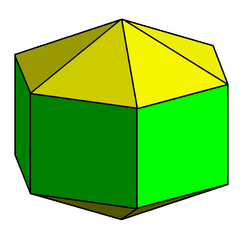Elongated hexagonal bipyramid
| Elongated hexagonal bipyramid | |
|---|---|
 | |
| Type | Elongated dipyramid |
| Faces |
12 triangles 6 squares |
| Edges | 30 |
| Vertices | 14 |
| Vertex configuration |
2 of 36 12 of 32.42 |
| Symmetry group | D6h, [6,2], (*226) |
| Dual polyhedron | Hexagonal bifrustum |
| Properties | convex |
In geometry, the elongated hexagonal bipyramid is constructed by elongating a hexagonal bipyramid (by inserting a hexagonal prism between its congruent halves).
Related polyhedra
This polyhedron is in the family of elongated bipyramids, of which the first three can be Johnson solids: J14, J15 and J16. The hexagonal form can be constructed by all regular faces, but isn't a Johnson solid because 6 equilateral triangles would form six co-planar faces (in a regular hexagon).
Uses
- A quartz crystal is an example of an elongated hexagonal bipyramid. Because it has 18 faces, it can be called an octadecahedron.
- The edge-first orthogonal projection of a 24-cell is an elongated hexagonal bipyramid.
- Used as the outer structure of gelatin-based juice-delivery systems.
- Used a physical manifestation for assisting various branches of three-dimensional graph theory
This article is issued from Wikipedia - version of the 2/28/2014. The text is available under the Creative Commons Attribution/Share Alike but additional terms may apply for the media files.